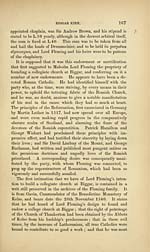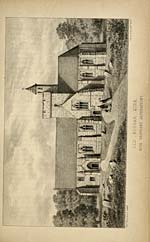Biggar and the House of Fleming
(194) Page 176
Download files
Complete book:
Individual page:
Thumbnail gallery: Grid view | List view

168 BIGGAK AND THE HOUSE OF FLEMING.
anxious that his lordship should not be diverted from his
resolution, or suffer prejudice by the Abbots of Kelso continuing
to hold the patronage of the Church of Thankerton. On these
grounds, with consent of David Hamilton, then rector of the
said church, he transferred to Lord Fleming, in name of the
college to be founded and built, the right of patronage of that
church, with its whole rents and emoluments, to be bestowed
on one or more prebendaries of the foresaid college. The only
reservation which he made, was that the Church of Thanker-
ton should always be provided with a vicar pensioner, who
should discharge the clerical duties of the charge, and have for
his sustentation twenty merks Scots out of the first and
readiest of the teinds of the parish, with a house, garden, and
four acres of land. This writ was confirmed by the Archbishop
of Glasgow, at Edinburgh, 1st May 1542.
The new church was founded in 1545, and erected on the
site of the old building dedicated to St Nicholas. The parson
of the old church at the time was Thomas Chappell, who, on
the presentation of Malcolm Lord Fleming, was collated to his
office by the Archbishop of Glasgow, on the 17th April 1542.
It has been supposed by some persons, and among others by
Grose, that the present edifice is much older than the date
above mentioned. This, to some extent, at least, is certainly
a mistake. From statements in the founder's testament, exe-
cuted in 1547, and also in a charter of the Abbot and Chapter
of Holyrood connected with this Church, and dated a few years
afterwards, it is evident that the erection had been commenced
and carried on, to some extent, by the founder, Malcolm Lord
Fleming, but was evidently left unfinished at his death, in
1547. His son and successor, James Lord Fleming, belonged
to the same religious and political party as his father, and was,
no doubt, influenced by the same views and feelings in respect
to the new collegiate Church. He is understood to have
carried on the building, and to have left it in nearly the same
state in which it exists at present.
The style of the architecture of the Church is Gothic, and
the form of it is that of a cross. It was, no doubt, intended
to be all composed of ashlar work. The choir, transepts, and
tower have accordingly been built of dressed sandstone, brought
evidently from a quarry in the parish of Libberton, near Cam-
anxious that his lordship should not be diverted from his
resolution, or suffer prejudice by the Abbots of Kelso continuing
to hold the patronage of the Church of Thankerton. On these
grounds, with consent of David Hamilton, then rector of the
said church, he transferred to Lord Fleming, in name of the
college to be founded and built, the right of patronage of that
church, with its whole rents and emoluments, to be bestowed
on one or more prebendaries of the foresaid college. The only
reservation which he made, was that the Church of Thanker-
ton should always be provided with a vicar pensioner, who
should discharge the clerical duties of the charge, and have for
his sustentation twenty merks Scots out of the first and
readiest of the teinds of the parish, with a house, garden, and
four acres of land. This writ was confirmed by the Archbishop
of Glasgow, at Edinburgh, 1st May 1542.
The new church was founded in 1545, and erected on the
site of the old building dedicated to St Nicholas. The parson
of the old church at the time was Thomas Chappell, who, on
the presentation of Malcolm Lord Fleming, was collated to his
office by the Archbishop of Glasgow, on the 17th April 1542.
It has been supposed by some persons, and among others by
Grose, that the present edifice is much older than the date
above mentioned. This, to some extent, at least, is certainly
a mistake. From statements in the founder's testament, exe-
cuted in 1547, and also in a charter of the Abbot and Chapter
of Holyrood connected with this Church, and dated a few years
afterwards, it is evident that the erection had been commenced
and carried on, to some extent, by the founder, Malcolm Lord
Fleming, but was evidently left unfinished at his death, in
1547. His son and successor, James Lord Fleming, belonged
to the same religious and political party as his father, and was,
no doubt, influenced by the same views and feelings in respect
to the new collegiate Church. He is understood to have
carried on the building, and to have left it in nearly the same
state in which it exists at present.
The style of the architecture of the Church is Gothic, and
the form of it is that of a cross. It was, no doubt, intended
to be all composed of ashlar work. The choir, transepts, and
tower have accordingly been built of dressed sandstone, brought
evidently from a quarry in the parish of Libberton, near Cam-
Set display mode to:
![]() Universal Viewer |
Universal Viewer | ![]() Mirador |
Large image | Transcription
Mirador |
Large image | Transcription
Images and transcriptions on this page, including medium image downloads, may be used under the Creative Commons Attribution 4.0 International Licence unless otherwise stated. ![]()
| Histories of Scottish families > Biggar and the House of Fleming > (194) Page 176 |
|---|
| Permanent URL | https://digital.nls.uk/94841610 |
|---|
| Description | A selection of almost 400 printed items relating to the history of Scottish families, mostly dating from the 19th and early 20th centuries. Includes memoirs, genealogies and clan histories, with a few produced by emigrant families. The earliest family history goes back to AD 916. |
|---|

